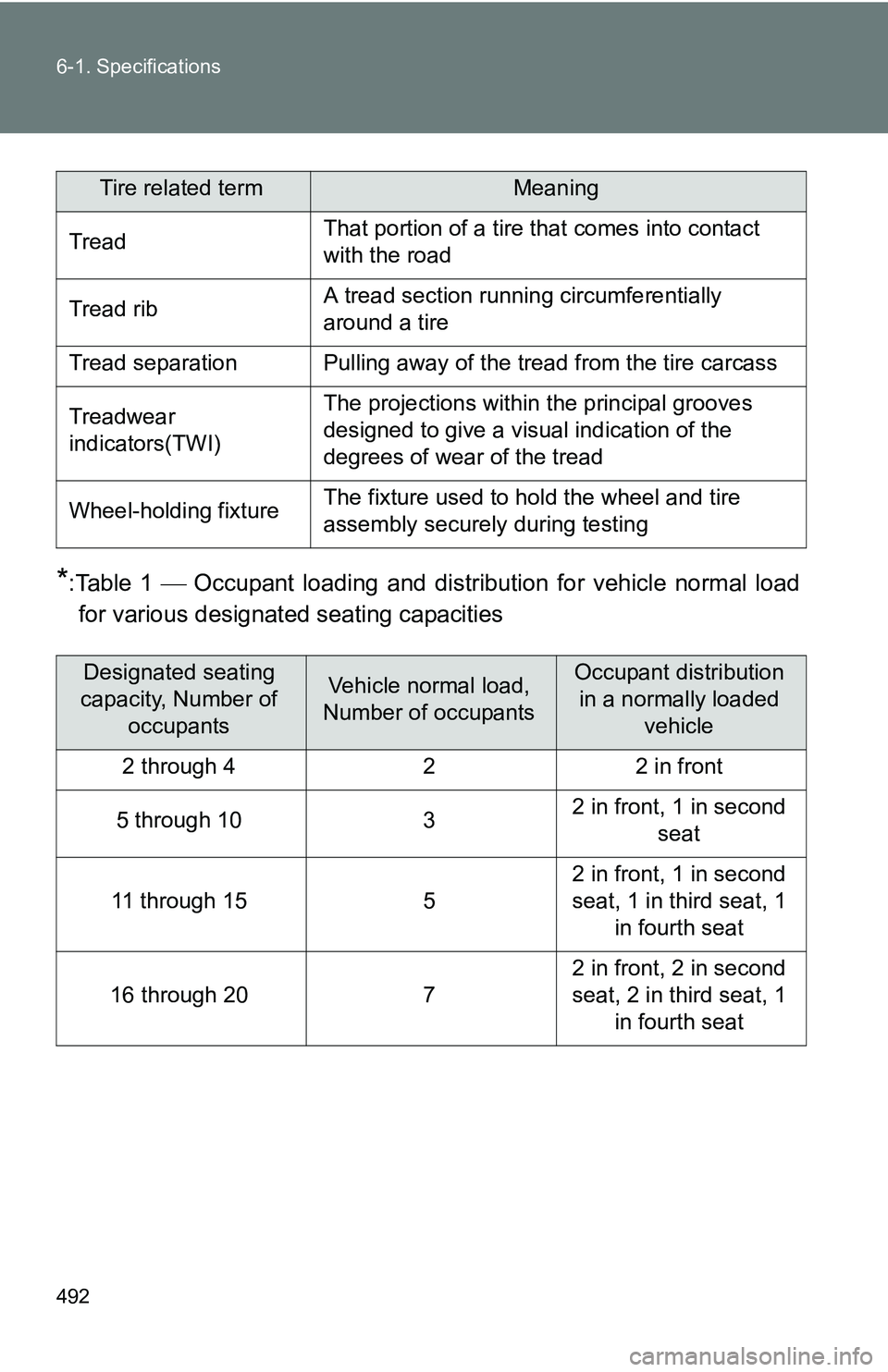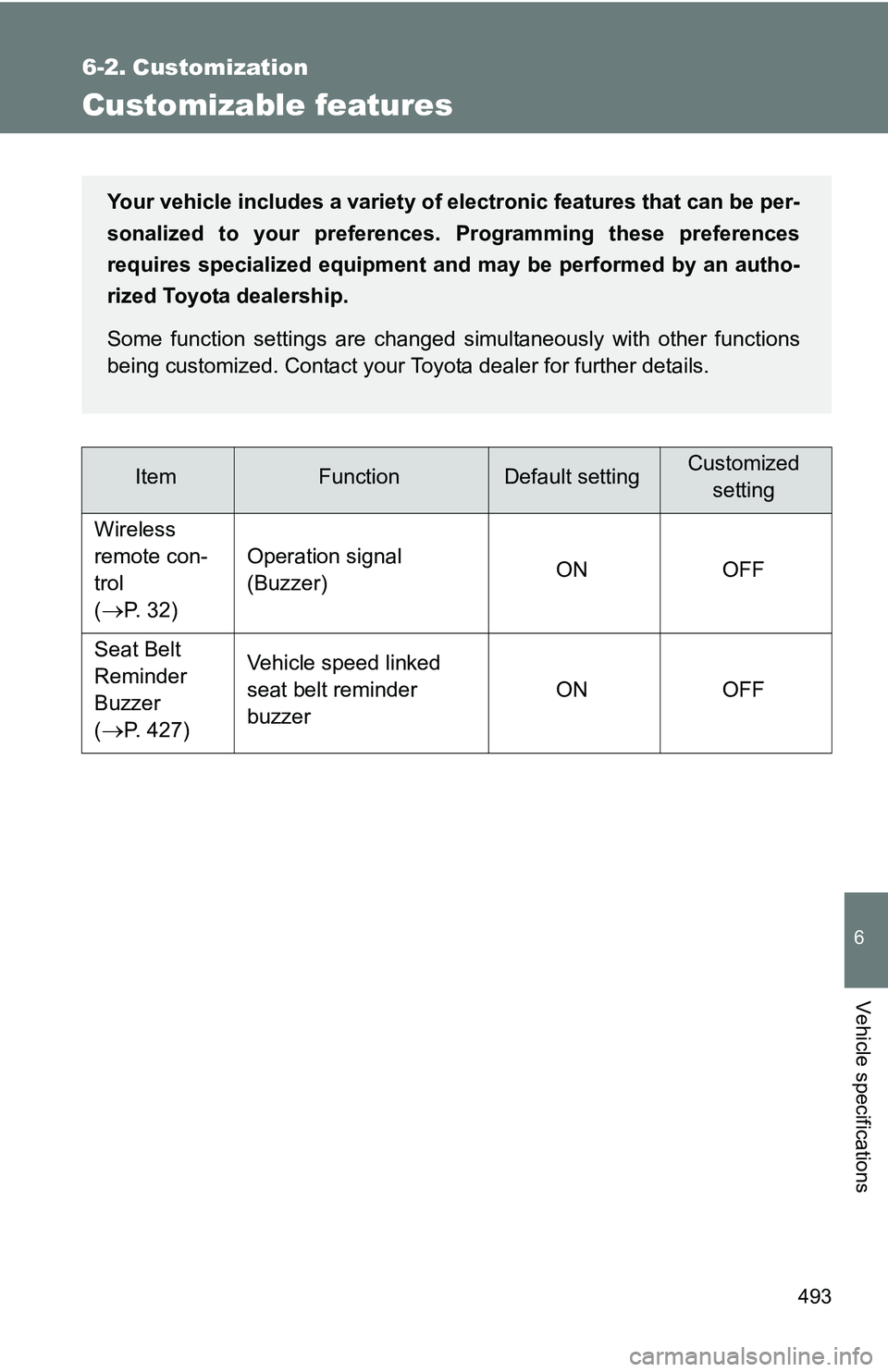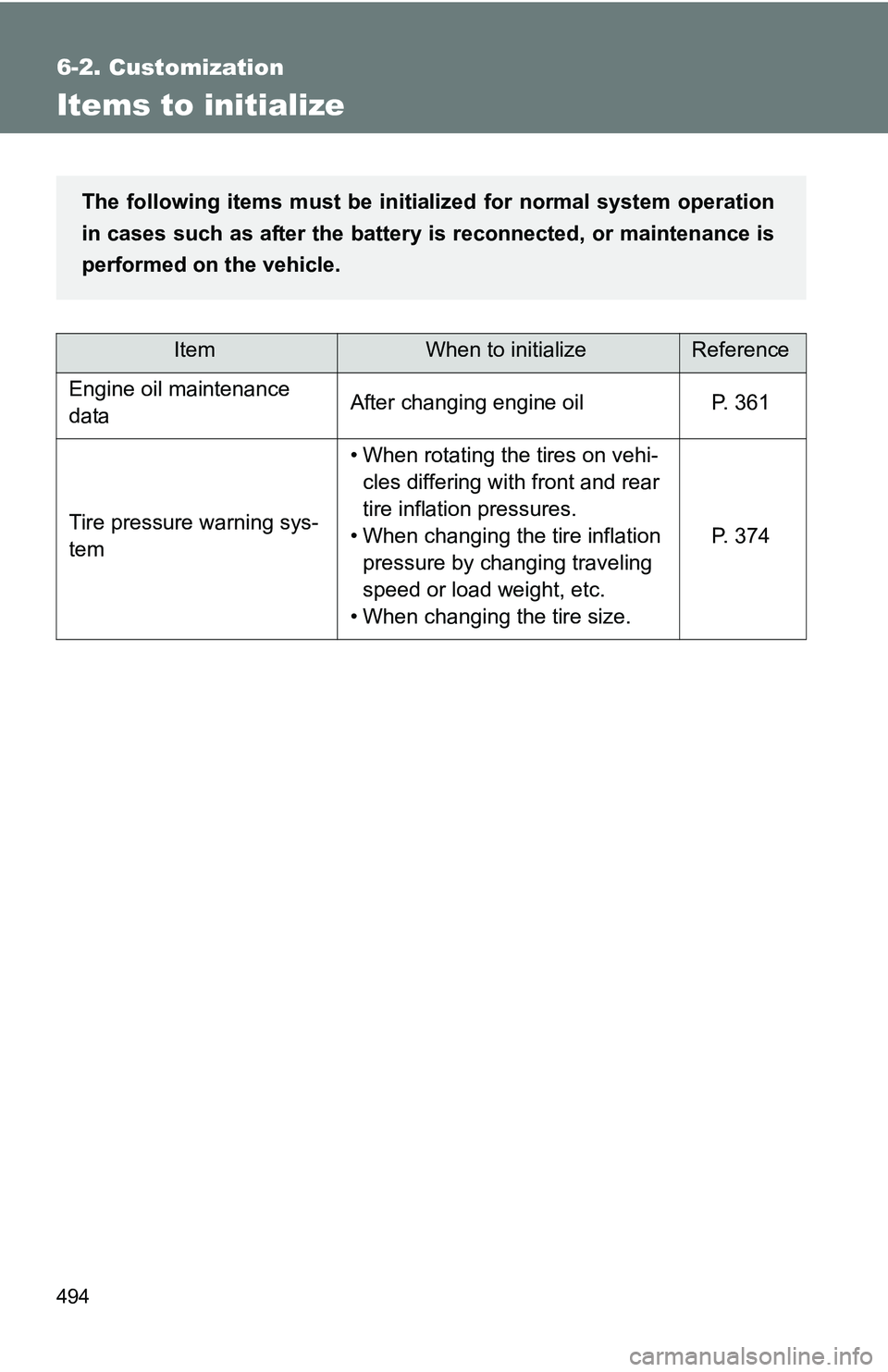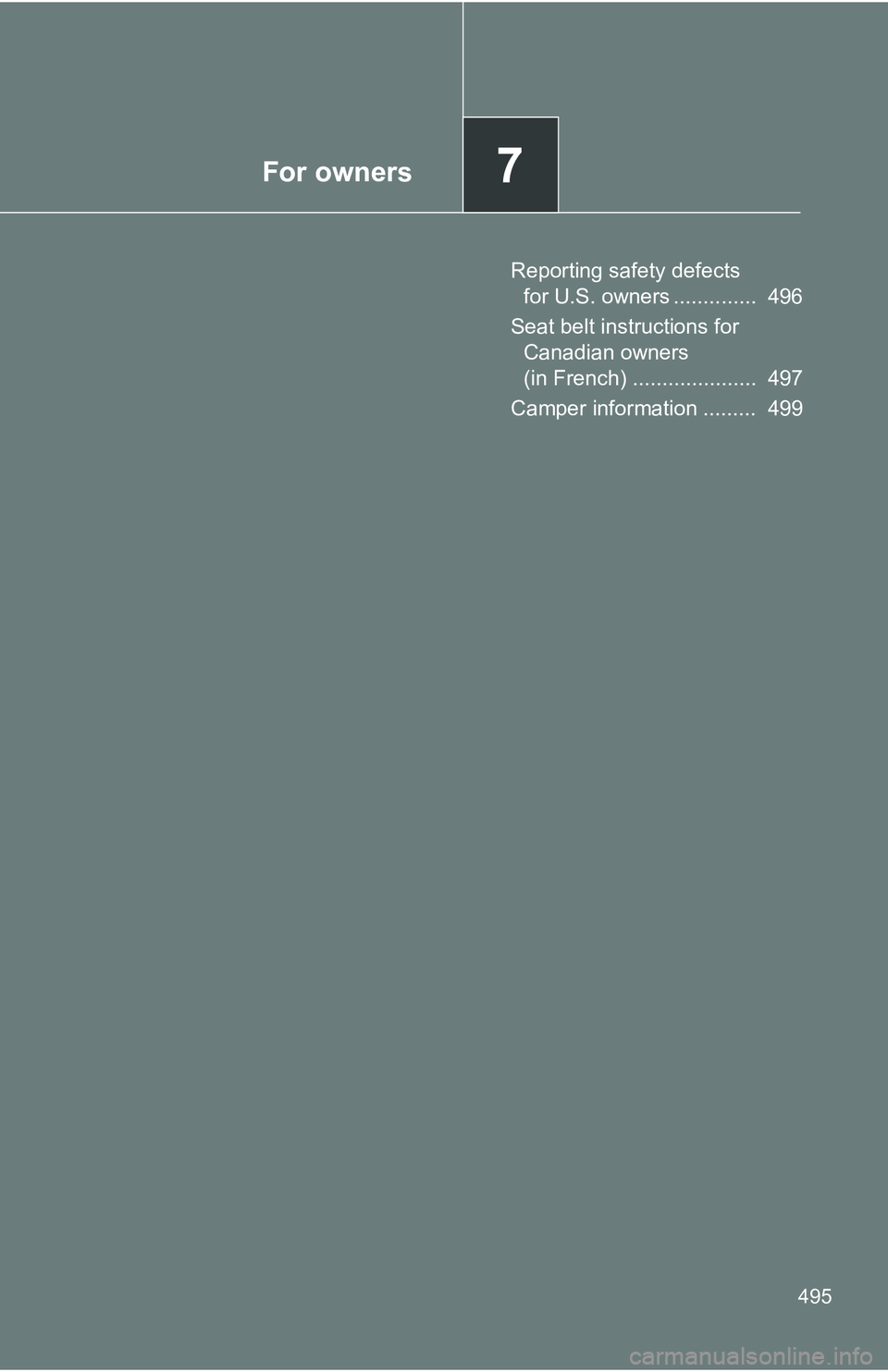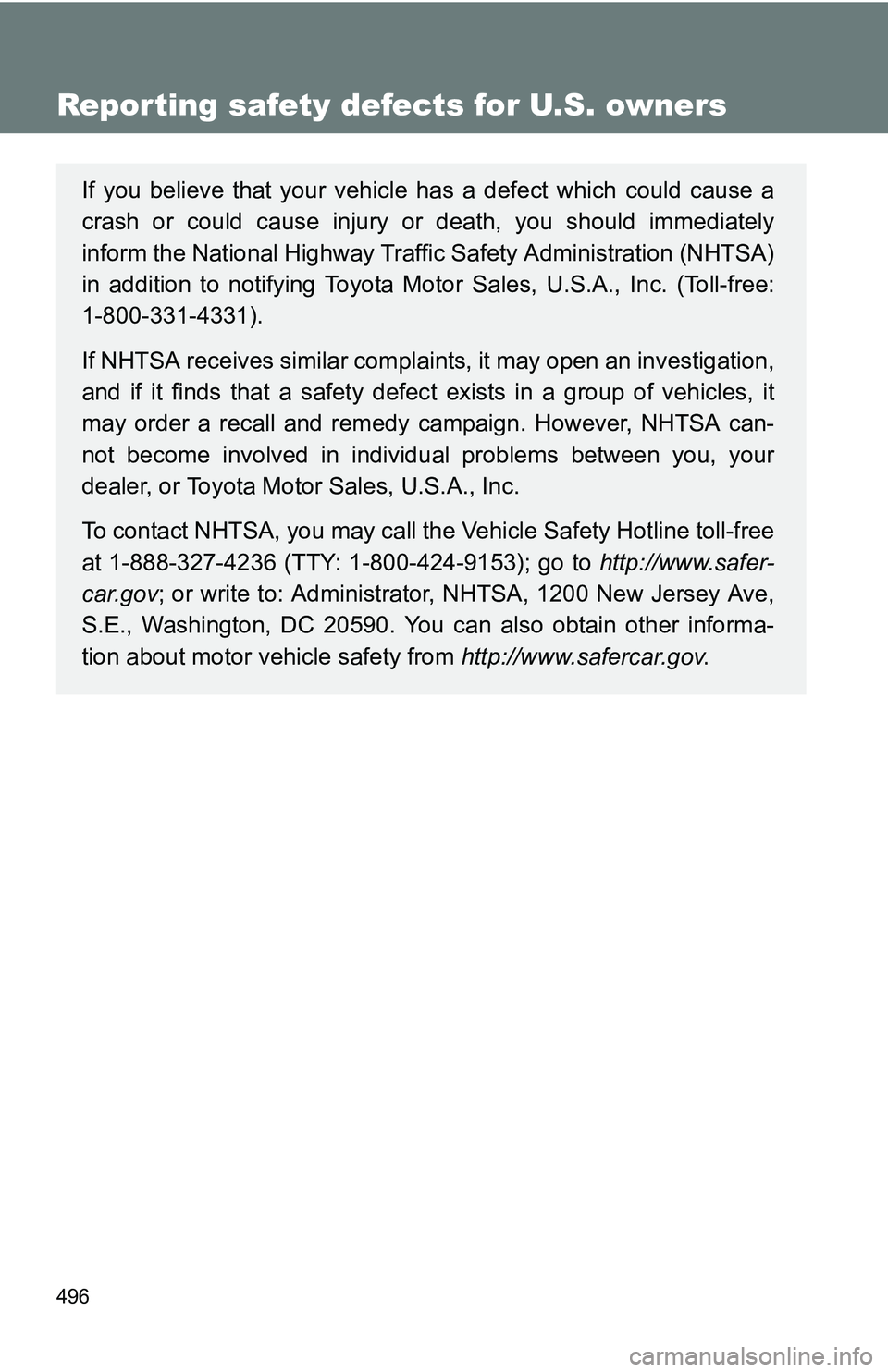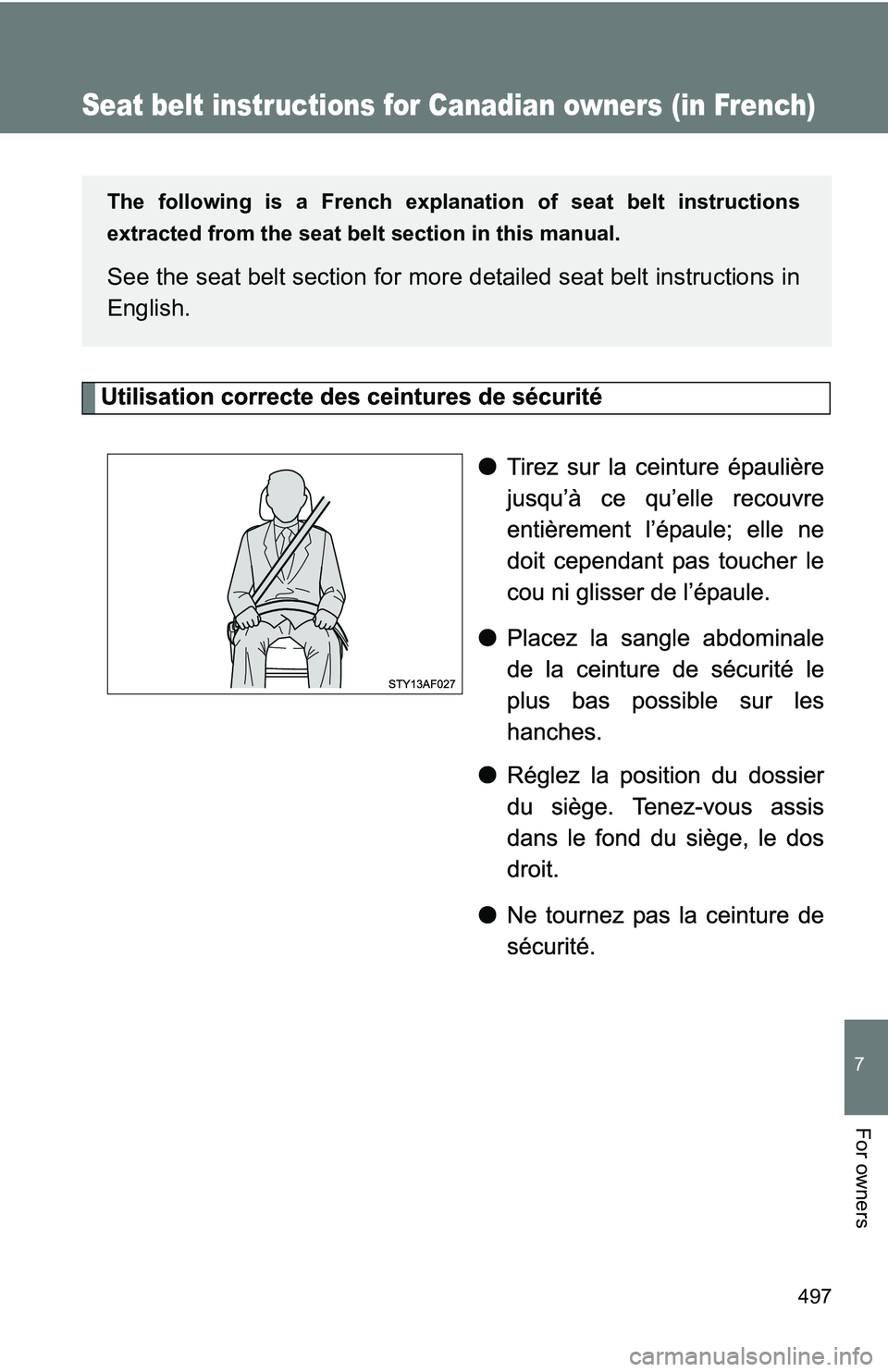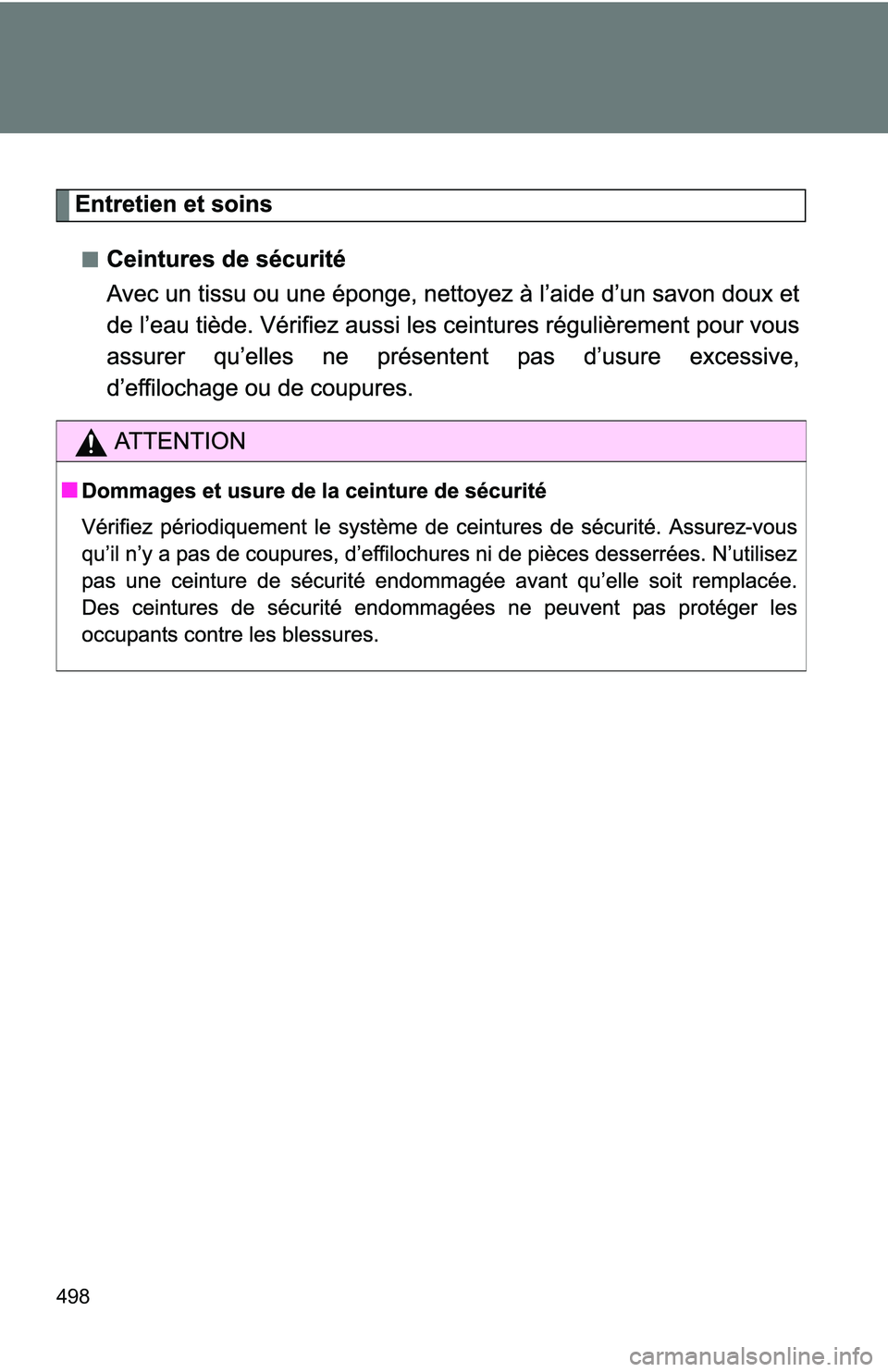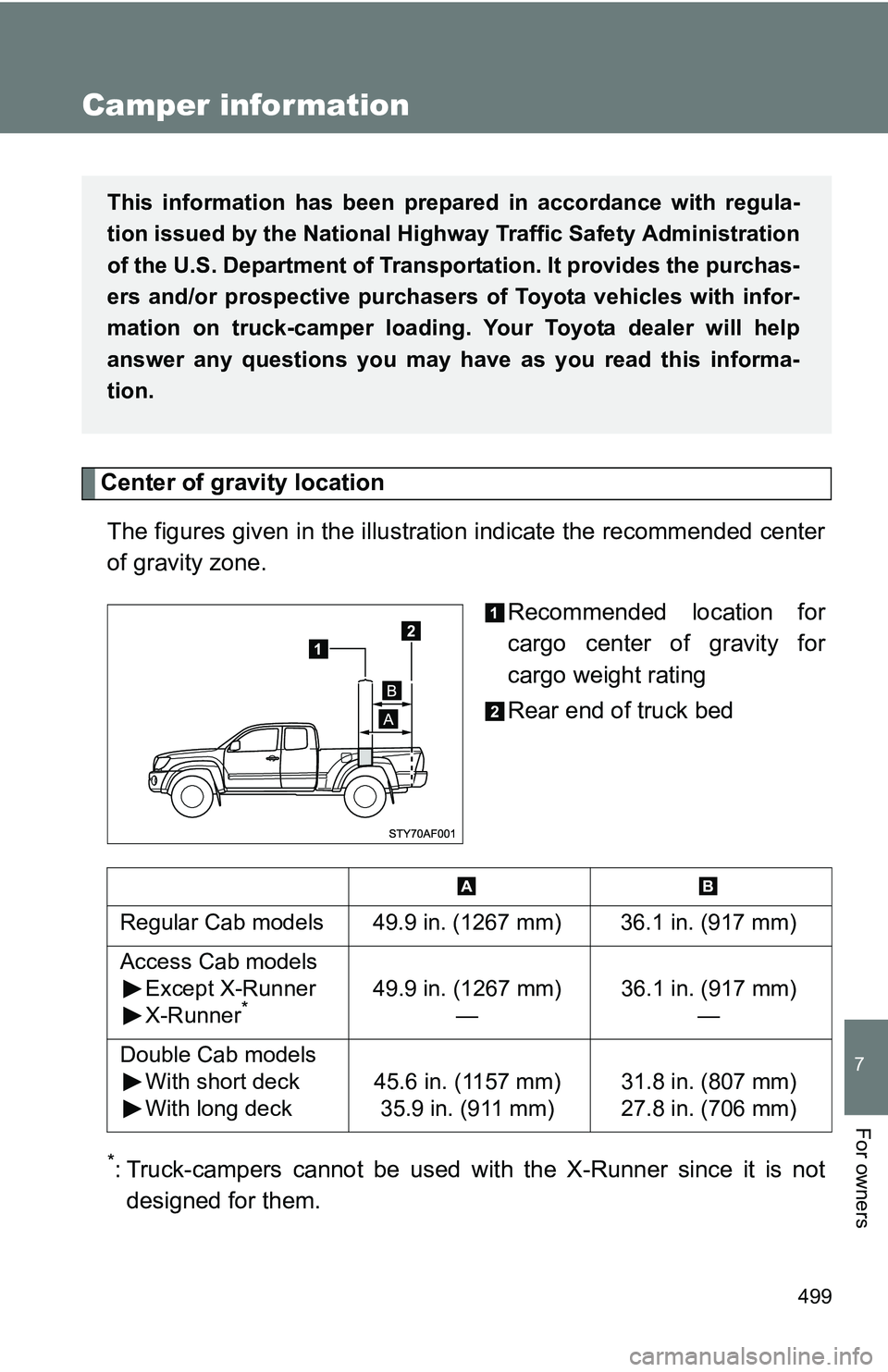TOYOTA TACOMA 2009 Owners Manual (in English)
TACOMA 2009
TOYOTA
TOYOTA
https://www.carmanualsonline.info/img/14/42940/w960_42940-0.png
TOYOTA TACOMA 2009 Owners Manual (in English)
Trending: width, wheel torque, coolant, change wheel, washer fluid, catalytic converter, mirror
Page 491 of 520
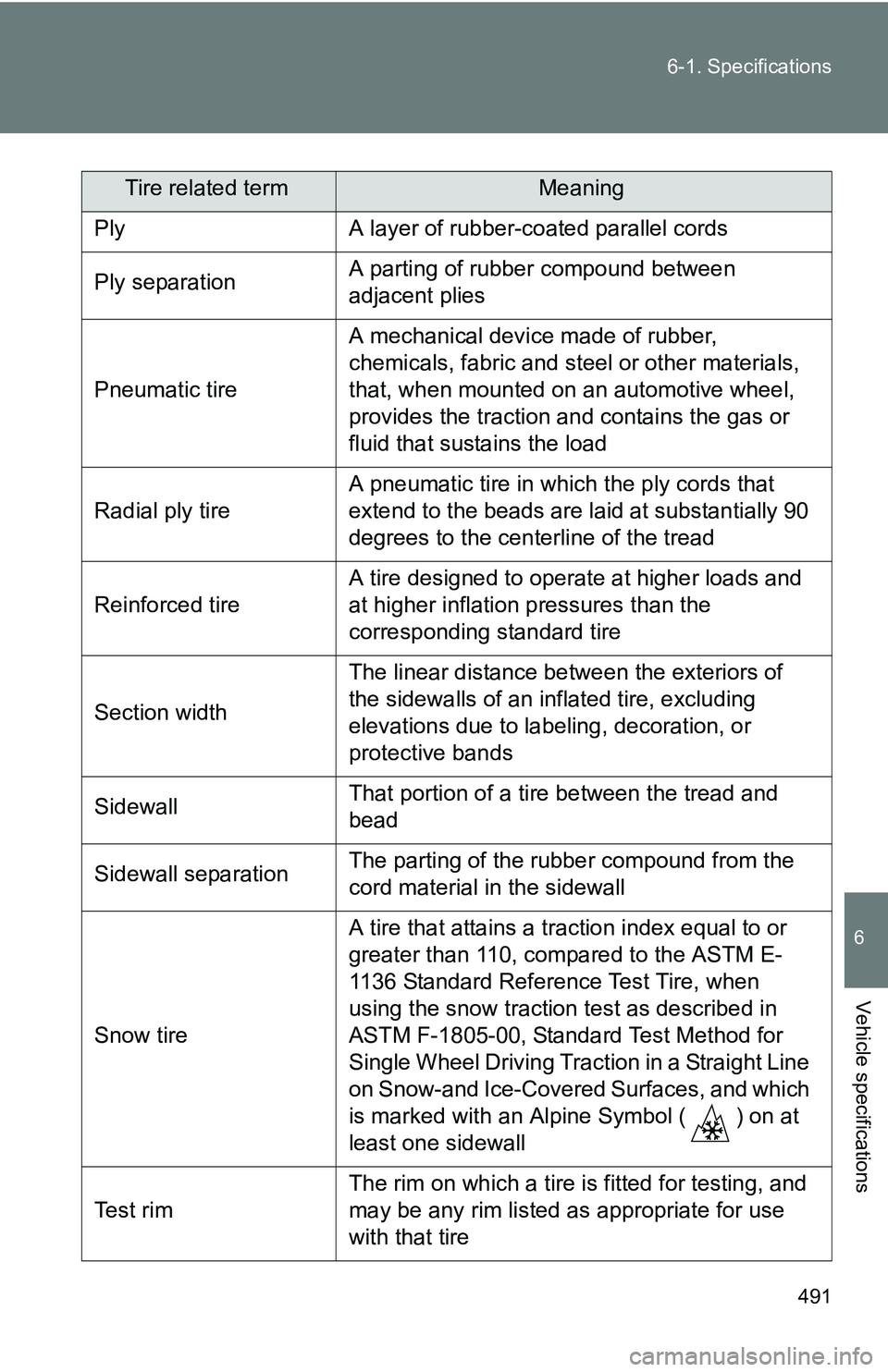
491
6-1. Specifications
6
Vehicle specifications
PlyA layer of rubber-coated parallel cords
Ply separationA parting of rubber compound between
adjacent plies
Pneumatic tire
A mechanical device made of rubber,
chemicals, fabric and steel or other materials,
that, when mounted on an automotive wheel,
provides the traction and contains the gas or
fluid that sustains the load
Radial ply tire
A pneumatic tire in which the ply cords that
extend to the beads are laid at substantially 90
degrees to the centerline of the tread
Reinforced tire
A tire designed to operate at higher loads and
at higher inflation pressures than the
corresponding standard tire
Section width
The linear distance between the exteriors of
the sidewalls of an inflated tire, excluding
elevations due to labeling, decoration, or
protective bands
SidewallThat portion of a tire between the tread and
bead
Sidewall separationThe parting of the rubber compound from the
cord material in the sidewall
Snow tire
A tire that attains a traction index equal to or
greater than 110, compared to the ASTM E-
1136 Standard Reference Test Tire, when
using the snow traction test as described in
ASTM F-1805-00, Standard Test Method for
Single Wheel Driving Traction in a Straight Line
on Snow-and Ice-Covered Surfaces, and which
is marked with an Alpine Symbol ( ) on at
least one sidewall
Te s t r i m
The rim on which a tire is fitted for testing, and
may be any rim listed as appropriate for use
with that tire
Tire related termMeaning
Page 492 of 520
492 6-1. Specifications
*:Table 1 Occupant loading and distri bution for vehicle normal load
for various designated seating capacities
TreadThat portion of a tire that comes into contact
with the road
Tread ribA tread section running circumferentially
around a tire
Tread separationPulling away of the tread from the tire carcass
Treadwear
indicators(TWI)The projections within the principal grooves
designed to give a visual indication of the
degrees of wear of the tread
Wheel-holding fixtureThe fixture used to hold the wheel and tire
assembly securely during testing
Designated seating
capacity, Number of occupants Vehicle normal load,
Number of occupantsOccupant distribution in a normally loaded vehicle
2 through 422 in front
5 through 1032 in front, 1 in second seat
11 through 155
2 in front, 1 in second
seat, 1 in third seat, 1 in fourth seat
16 through 207
2 in front, 2 in second
seat, 2 in third seat, 1 in fourth seat
Tire related termMeaning
Page 493 of 520
493
6
Vehicle specifications
6-2. Customization
Customizable features
ItemFunctionDefault settingCustomizedsetting
Wireless
remote con-
trol
(
P. 3 2 ) Operation signal
(Buzzer)
ON OFF
Seat Belt
Reminder
Buzzer
(
P. 427) Vehicle speed linked
seat belt reminder
buzzer
ON OFF
Your vehicle includes a variety of electronic features that can be per-
sonalized to your preferences.
Programming these preferences
requires specialized equipment and may be performed by an autho-
rized Toyota dealership.
Some function settings are changed simultaneously with other functions
being customized. Contact your Toyota dealer for further details.
Page 494 of 520
494
6-2. Customization
Items to initialize
ItemWhen to initializeReference
Engine oil maintenance
dataAfter changing engine oilP. 361
Tire pressure warning sys-
tem
• When rotating the tires on vehi-cles differing with front and rear
tire inflation pressures.
• When changing the tire inflation pressure by changing traveling
speed or load weight, etc.
• When changing the tire size.
P. 374
The following items must be initia lized for normal system operation
in cases such as after the battery is reconnected, or maintenance is
performed on the vehicle.
Page 495 of 520
For owners7
495
Reporting safety defects for U.S. owners .............. 496
Seat belt instructions for Canadian owners
(in French) ..................... 497
Camper information ......... 499
Page 496 of 520
496
Reporting safety defects for U.S. owners
If you believe that your vehicle has a defect which could cause a
crash or could cause injury or death, you should immediately
inform the National Highway Traffi c Safety Administration (NHTSA)
in addition to notifying Toyota Motor Sales, U.S.A., Inc. (Toll-free:
1-800-331-4331).
If NHTSA receives similar complaints, it may open an investigation,
and if it finds that a safety defec t exists in a group of vehicles, it
may order a recall and remedy campaign. However, NHTSA can-
not become involved in individ ual problems between you, your
dealer, or Toyota Motor Sales, U.S.A., Inc.
To contact NHTSA, you may call the Vehicle Safety Hotline toll-free
at 1-888-327-4236 (TTY: 1-800-424-9153); go to http://www.safer-
car.gov; or write to: Administrator, NHTSA, 1200 New Jersey Ave,
S.E., Washington, DC 20590. You can also obtain other informa-
tion about motor vehicle safety from http://www.safercar.gov.
Page 497 of 520
497
7
For owners
Seat belt instructions for Canadian owners (in French)
The following is a French explanation of seat belt instructions
extracted from the seat belt section in this manual.
See the seat belt section for more detailed seat belt instructions in
English.
Page 498 of 520
Page 499 of 520
499
7
For owners
Camper information
Center of gravity locationThe figures given in the illustration indicate the recommended center
of gravity zone. Recommended location for
cargo center of gravity for
cargo weight rating
Rear end of truck bed
*: Truck-campers cannot be used with the X-Runner since it is not
designed for them.
This information has been prepared in accordance with regula-
tion issued by the National Highway Traffic Safety Administration
of the U.S. Department of Transportation. It provides the purchas-
ers and/or prospective purchasers of Toyota vehicles with infor-
mation on truck-camper loading. Your Toyota dealer will help
answer any questions you may have as you read this informa-
tion.
Regular Cab models 49.9 in. (1267 mm) 36.1 in. (917 mm)
Access Cab models Except X-Runner
X-Runner
*49.9 in. (1267 mm) — 36.1 in. (917 mm)
—
Double Cab models With short deck
With long deck 45.6 in. (1157 mm)
35.9 in. (911 mm) 31.8 in. (807 mm)
27.8 in. (706 mm)
Page 500 of 520
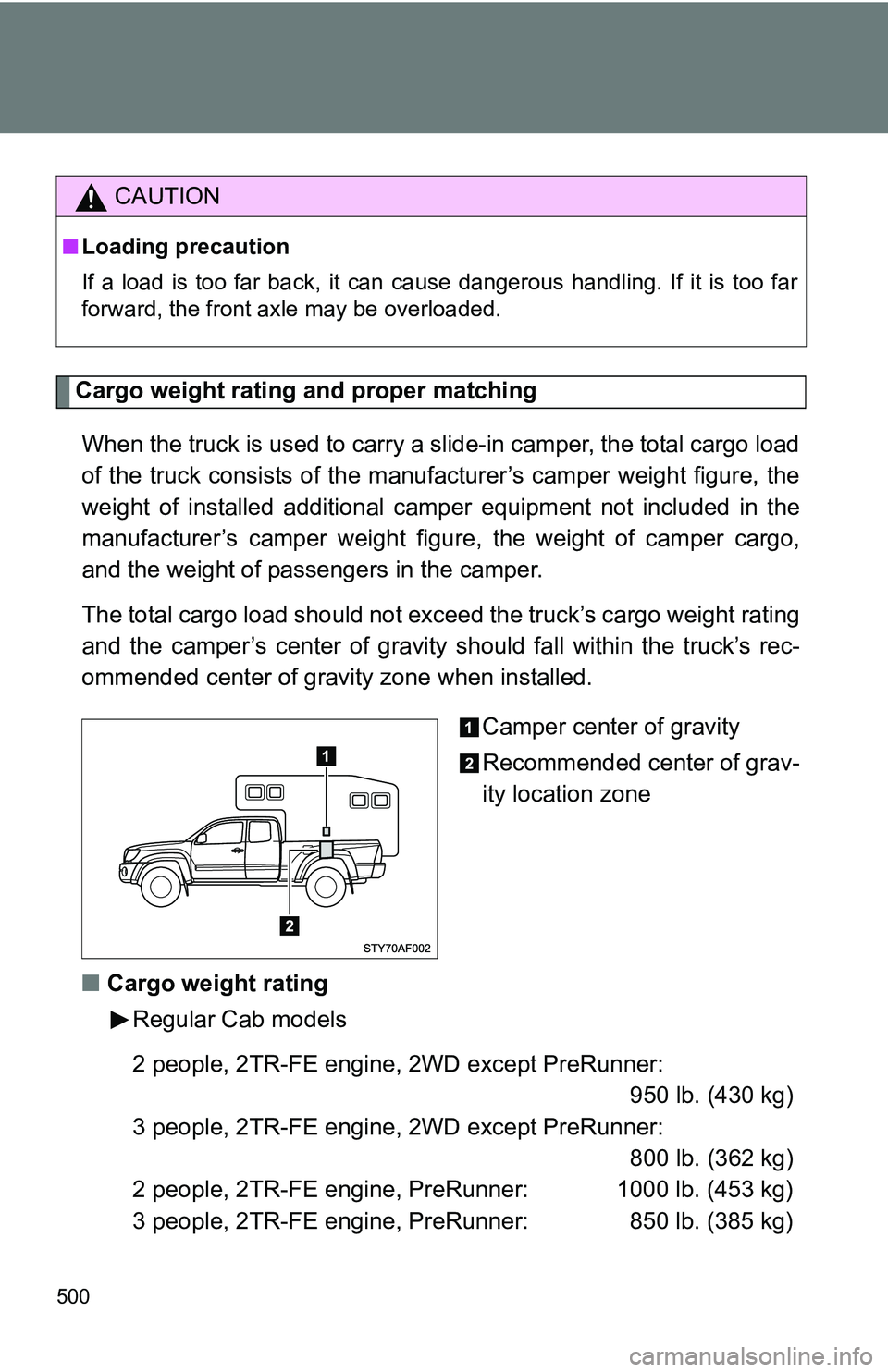
500
Cargo weight rating and proper matchingWhen the truck is used to carry a slide-in camper, the total cargo load
of the truck consists of the manufacturer’s camper weight figure, the
weight of installed additional camper equipment not included in the
manufacturer’s camper weight figu re, the weight of camper cargo,
and the weight of passengers in the camper.
The total cargo load should not exceed the truck’s cargo weight rating
and the camper’s center of gravity should fall within the truck’s rec-
ommended center of gravity zone when installed.
Camper center of gravity
Recommended center of grav-
ity location zone
■ Cargo weight rating
Regular Cab models
2 people, 2TR-FE engine, 2WD except PreRunner: 950 lb. (430 kg)
3 people, 2TR-FE engine, 2WD except PreRunner: 800 lb. (362 kg)
2 people, 2TR-FE engine, PreRunner: 1000 lb. (453 kg)
3 people, 2TR-FE engine, PreRunner: 850 lb. (385 kg)
CAUTION
■Loading precaution
If a load is too far back, it can cause dangerous handling. If it is too far
forward, the front axle may be overloaded.
Trending: glove box, oil temperature, snow chains, coolant capacity, spare wheel, open gas tank, steering

